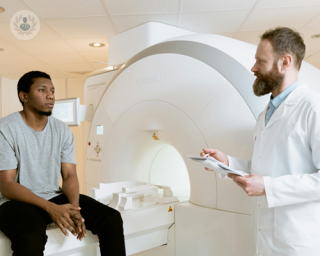What is a coronary angiography?
A coronary angiogram, also known as coronary angiography, is an examination carried out with an X-ray in which the coronary arteries are visualised, along with the blood vessels that surround the heart, whose function is to transport blood to the heart. To visualise the arteries, a special type of dye called contrast medium is injected and X-ray images are taken to visualise the coronary arteries and their circulation. The dye is released via a catheter, which is a thin hollow tube, inserted in the blood vessels and guided up to the coronary arteries.

What does it involve?
The procedure is carried out under local anaesthetic that is applied to the area where the catheter is inserted. The anaesthetic is applied via one of the major arteries of the human body, the brachial, radial, or femoral artery. However, the femoral artery is preferred as it is the largest, and it allows a faster passage of the anaesthetic without the need forany further manual interventions.
The catheter is guided up to the coronary artery where the dye will show any blockages in the artery. At the end of the procedure, the specialist will remove the catheter and will press on the area with a tourniquet in order to stop any bleeding. The procedure does not require a long recovery or any other manipulation to the wound site.
Why would you need a coronary angiogram?
A coronary angiogram is carried out to evaluate the blood flow inside the coronary arteries. This test allows the specialist to observe the arteries and find any blockages, such as clots or cholesterol build-ups.
The test may be prescribed in the following cases:
- Coronary artery disease
- Genetic heart conditions present from birth
- Genetic defects or defects acquired through different cardiac valve diseases
- Sudden acute pain in the chest or arm
- Cardiac insufficiency
- Planning and/or evaluating the possibility of a surgical intervention
- Checking the results of a previous procedure, for example a bypass
How should I prepare for a coronary angiography?
The preparation for the test is rather simple: you must come on the day of the test with an empty stomach. The specialist will carry out a prior test to evaluate any possible allergies to the contrast medium. The coronary angiogram is an invasive test, and for this reason, it is only carried out when all other non-invasive tests have failed to determine the cause of the pathology.
Nowadays, the procedure is not painful thanks to the local anaesthetic used in the area where the catheter is introduced and the contrast liquid is released, so you will not feel any discomfort.
What do you feel during the test?
Since the test is performed with anaesthetic, you will not feel any pain. The following day, it is possible that you may feel soreness in the area where the catheter was inserted, but it will not last long.
If the catheter has been inserted in the groin, it is necessary that you rest for the following 12 hours after the test. It is also important that you drink lots of water to eliminate the contrast medium used during the procedure.
10-21-2015 06-07-2023Coronary angiography
What is a coronary angiography?
A coronary angiogram, also known as coronary angiography, is an examination carried out with an X-ray in which the coronary arteries are visualised, along with the blood vessels that surround the heart, whose function is to transport blood to the heart. To visualise the arteries, a special type of dye called contrast medium is injected and X-ray images are taken to visualise the coronary arteries and their circulation. The dye is released via a catheter, which is a thin hollow tube, inserted in the blood vessels and guided up to the coronary arteries.

What does it involve?
The procedure is carried out under local anaesthetic that is applied to the area where the catheter is inserted. The anaesthetic is applied via one of the major arteries of the human body, the brachial, radial, or femoral artery. However, the femoral artery is preferred as it is the largest, and it allows a faster passage of the anaesthetic without the need forany further manual interventions.
The catheter is guided up to the coronary artery where the dye will show any blockages in the artery. At the end of the procedure, the specialist will remove the catheter and will press on the area with a tourniquet in order to stop any bleeding. The procedure does not require a long recovery or any other manipulation to the wound site.
Why would you need a coronary angiogram?
A coronary angiogram is carried out to evaluate the blood flow inside the coronary arteries. This test allows the specialist to observe the arteries and find any blockages, such as clots or cholesterol build-ups.
The test may be prescribed in the following cases:
- Coronary artery disease
- Genetic heart conditions present from birth
- Genetic defects or defects acquired through different cardiac valve diseases
- Sudden acute pain in the chest or arm
- Cardiac insufficiency
- Planning and/or evaluating the possibility of a surgical intervention
- Checking the results of a previous procedure, for example a bypass
How should I prepare for a coronary angiography?
The preparation for the test is rather simple: you must come on the day of the test with an empty stomach. The specialist will carry out a prior test to evaluate any possible allergies to the contrast medium. The coronary angiogram is an invasive test, and for this reason, it is only carried out when all other non-invasive tests have failed to determine the cause of the pathology.
Nowadays, the procedure is not painful thanks to the local anaesthetic used in the area where the catheter is introduced and the contrast liquid is released, so you will not feel any discomfort.
What do you feel during the test?
Since the test is performed with anaesthetic, you will not feel any pain. The following day, it is possible that you may feel soreness in the area where the catheter was inserted, but it will not last long.
If the catheter has been inserted in the groin, it is necessary that you rest for the following 12 hours after the test. It is also important that you drink lots of water to eliminate the contrast medium used during the procedure.


CT coronary angiogram scan: your all-you-need-to-know guide
By Dr Iqbal Malik
2025-02-05
Read this patient-journey-style guide where highly esteemed London-based cardiologist, Dr Iqbal Malik, answers all the essential questions you might have before going for a CT coronary angiogram scan. See more


Beating heart coronary bypass surgery explained
By Mr Alberto Albanese
2025-02-04
Beating heart coronary bypass surgery offers a shorter recovery time, fewer risks and better outcomes for cardiac surgery patients in comparison to more traditional bypass surgery techniques. We've invited renowned consultant cardiothoracic surgeon Mr Alberto Albanese to explain how this innovative procedure works and how patients with coronary artery disease can benefit. See more


CT coronary angiography: How is it performed and what does it detect?
By Dr Aftab Gill
2025-02-04
A CT coronary angiography is a test that analyses the heart and the coronary arteries surrounding the heart to identify if there are any blockages or any other heart-related problems that need to be treated. In this article, expert consultant cardiologist Dr Aftab Gill explains in detail what exactly a CT coronary angiography is, how it's performed and what it detects. See more


Exploring transcatheter aortic valve implantation (TAVI)
By Dr Mohamed Farag
2025-02-03
Transcatheter aortic valve implantation (TAVI), or TAVR, is a minimally invasive procedure used to treat aortic valve stenosis, a condition in which the aortic valve becomes narrowed, restricting blood flow from the heart to the rest of the body. Leading consultant interventional cardiologist Dr Mohamed Farag takes an in-depth look at TAVI and addresses some common questions patients may have about this procedure, in this article. See more
Experts in Coronary angiography
-
Dr Narbeh Melikian
CardiologyExpert in:
- Coronary angiography
- Pacemaker
- Atrial Fibrillation
- Heart failure
- Heart valve surgery
- Tachycardia
-
Dr Nicholas Robinson
CardiologyExpert in:
- Chest pain
- Heart check up
- Angina
- Heart attack
- Stent
- Coronary angiography
-
Dr Rodney Foale
CardiologyExpert in:
- Chest pain
- Coronary angiography
- Coronary angioplasty
- Heart check up
- Hypertension (high blood pressure)
- Valvular heart disease
-
Dr Deepak Goyal
CardiologyExpert in:
- Coronary heart disease
- Hypertension (high blood pressure)
- Heart failure
- Interventional cardiology
- Coronary angiography
- Palpitations
-
Dr Peter Clarkson
CardiologyExpert in:
- Cardiovascular Medicine
- Coronary heart disease
- Heart failure
- Coronary angiography
- Interventional cardiology
- Pacemaker
- See all

OneWelbeck Heart Health
OneWelbeck Heart Health
1 Welbeck St, London, W1G 0AR
No existe teléfono en el centro.
By using the telephone number provided by TOP DOCTORS, you automatically agree to let us use your phone number for statistical and commercial purposes. For further information, read our Privacy Policy
Top Doctors

Cleveland Clinic Portland Place Outpatient Centre
Cleveland Clinic Portland Place Outpatient Centre
24 Portland Place, W1B 1LU
No existe teléfono en el centro.
By using the telephone number provided by TOP DOCTORS, you automatically agree to let us use your phone number for statistical and commercial purposes. For further information, read our Privacy Policy
Top Doctors

The Manor Hospital - part of Circle Health Group
The Manor Hospital - part of Circle Health Group
Church End, Biddenham, Bedford MK40 4AW
No existe teléfono en el centro.
By using the telephone number provided by TOP DOCTORS, you automatically agree to let us use your phone number for statistical and commercial purposes. For further information, read our Privacy Policy
Top Doctors
-
OneWelbeck Heart Health
1 Welbeck St, London, W1G 0AR, W1G Marylebone LondonExpert in:
- Clinical analysis
- Arrhythmia
- Palpitations
-
Cleveland Clinic Portland Place Outpatient Centre
24 Portland Place, W1B 1LU, Central LondonExpert in:
- Diagnosis of Cancer
- Diagnostics
- Women’s health
- Sports Medicine
- General practice
- Health check up
-
The Manor Hospital - part of Circle Health Group
Church End, Biddenham, Bedford MK40 4AW, BedfordExpert in:
- General Surgery
- Orthopaedic surgery
- Physiotherapy
- Obstetrics and Gynaecology
- General practice
- Urology
- See all
- Most viewed diseases, medical tests, and treatments
- Cardiovascular disease
- Cardiac screening
- Electrophysiology study
- Genetic testing
- Minimal access surgery (keyhole surgery)
- Aortic aneurysms
- Anxiety
- Long Covid
- Medicolegal
- Robotic surgery








